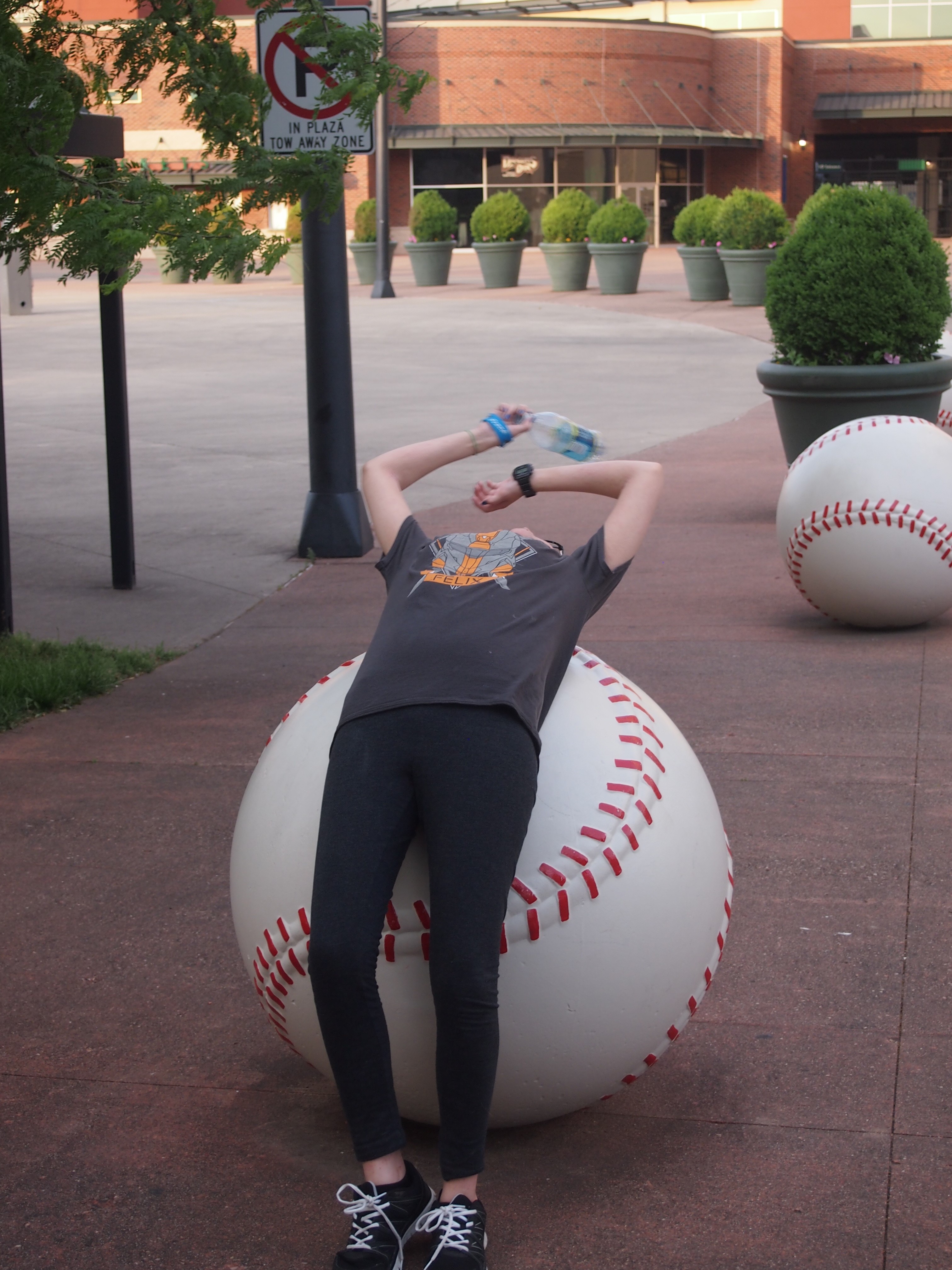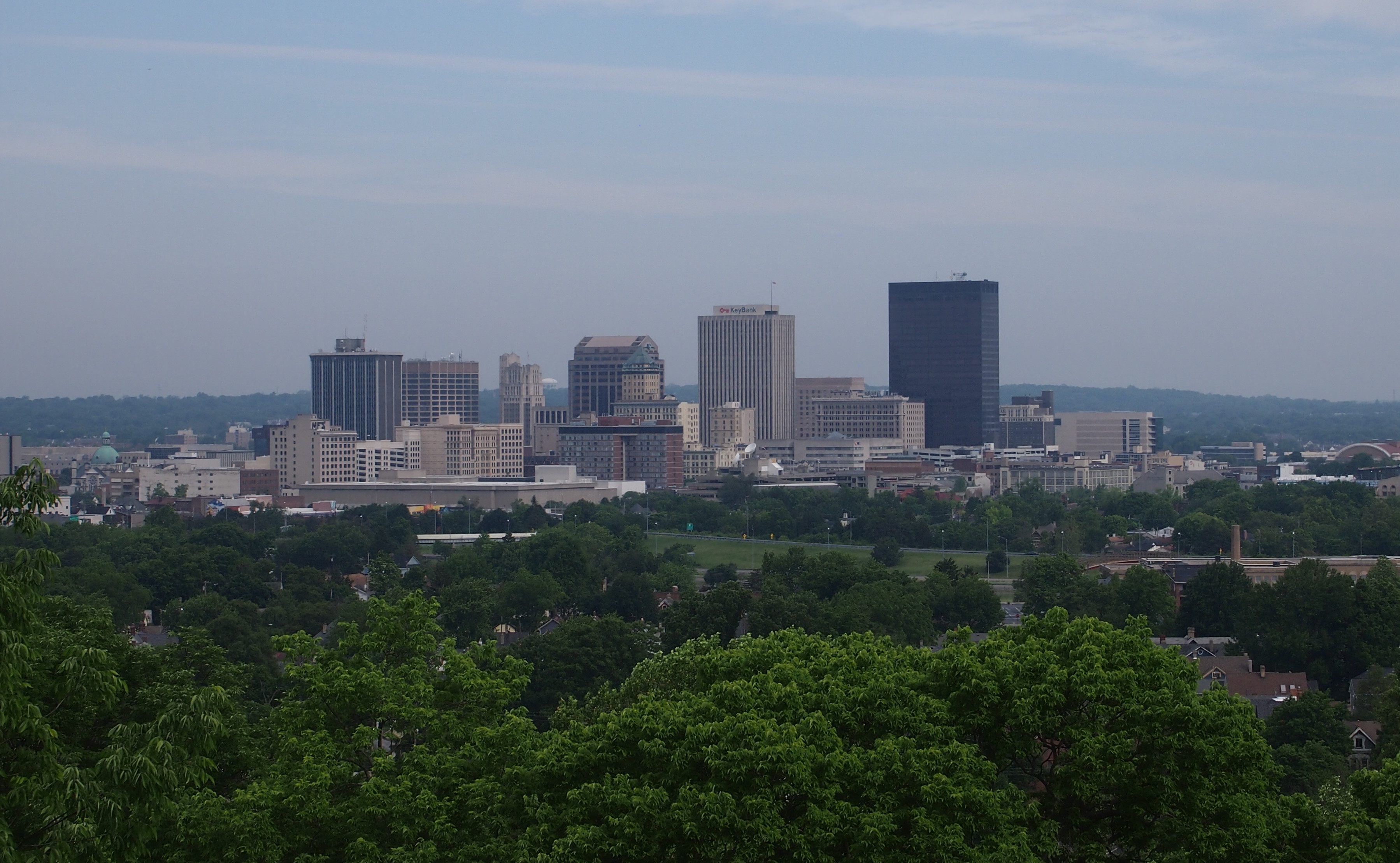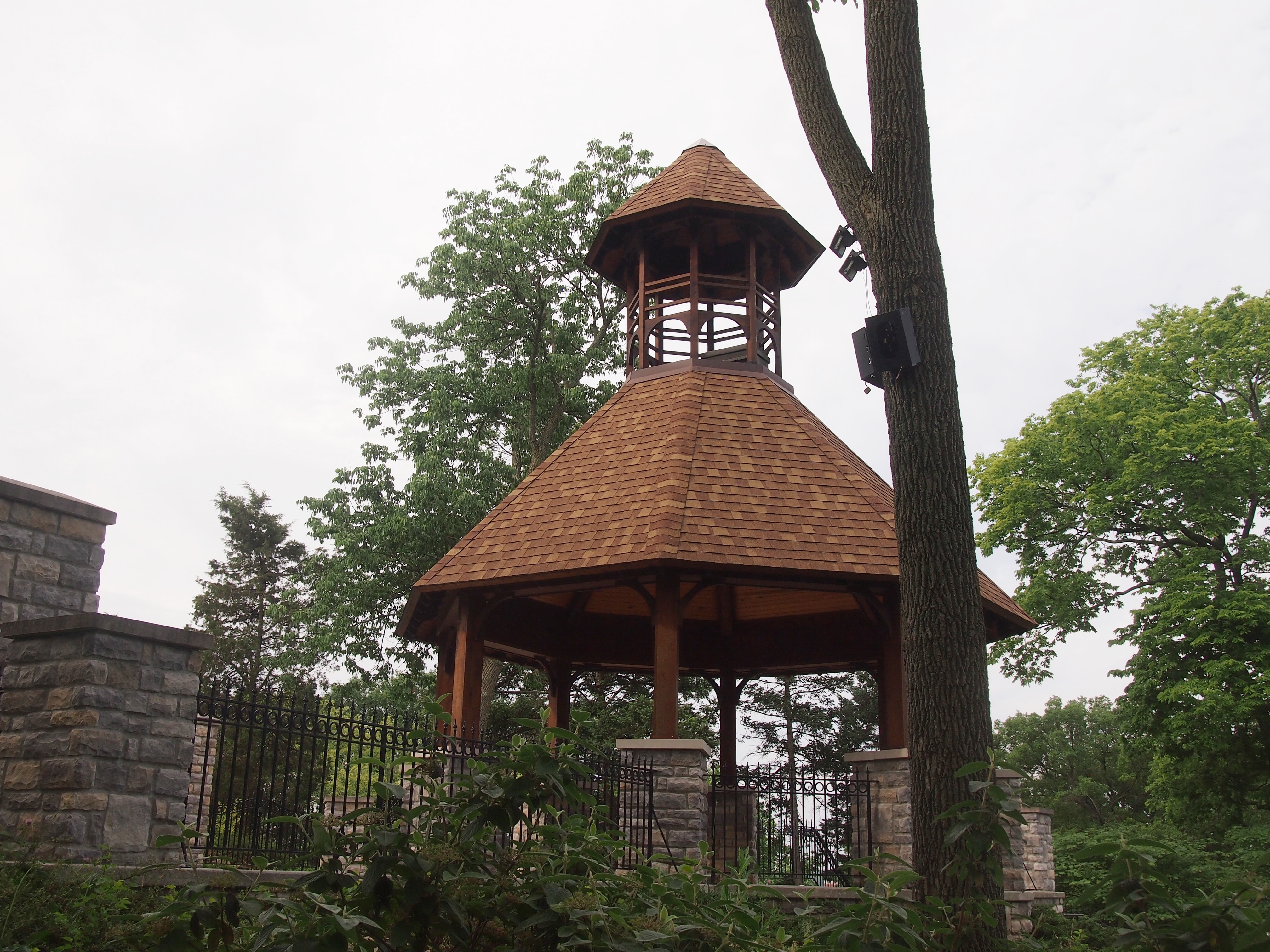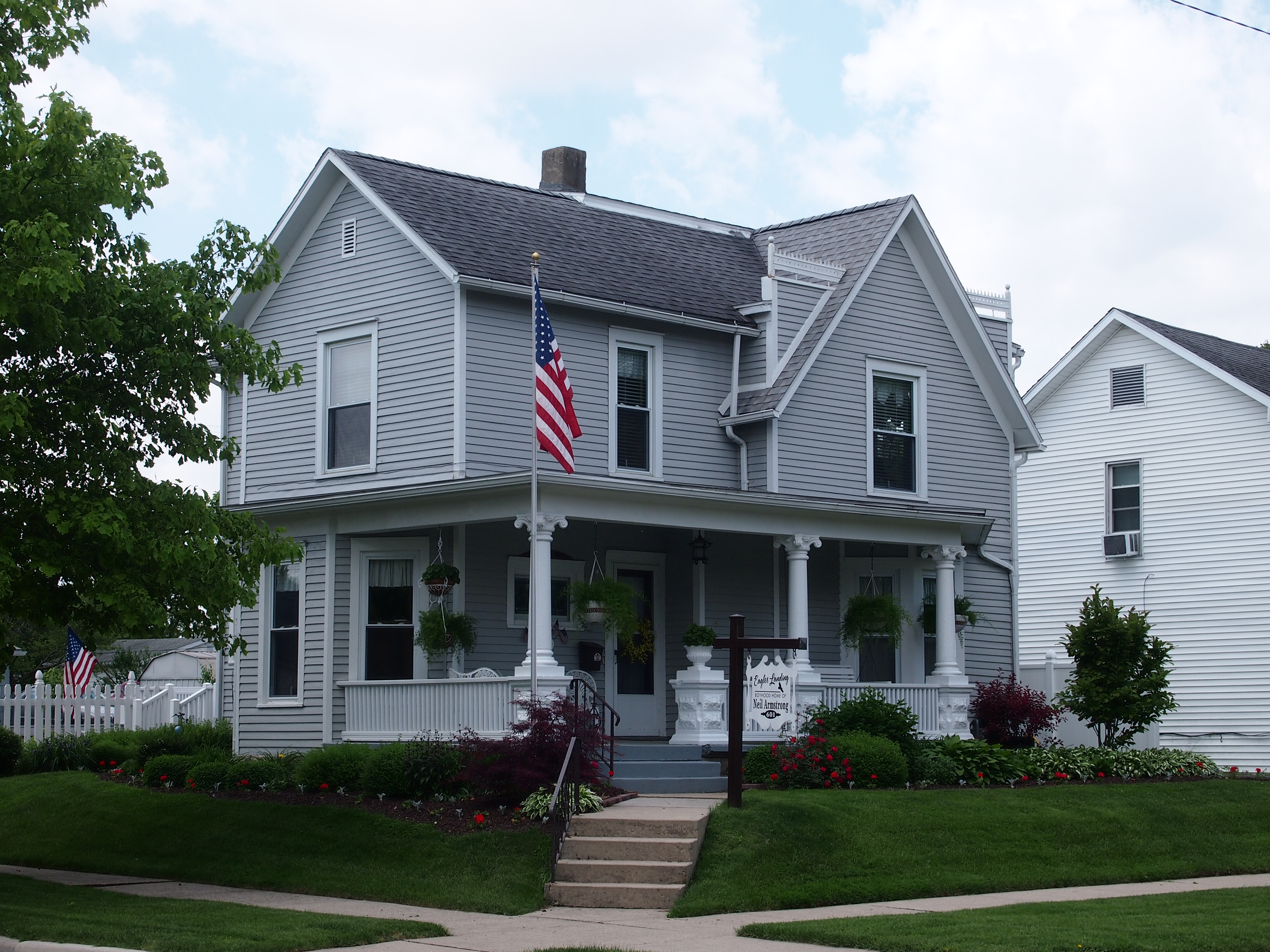We arrived in downtown Dayton late on a Friday afternoon, May 27, and from the look of things, Dayton isn’t an 18-hour city just yet. Municipal planners probably aspire to that: there’s been some nice infrastructure work at Riverscape Metro Park and Five Rivers Metro Park downtown, including walkways, an elegant garden, a pavilion and other public spaces that look fairly new. As for the private sector, I also spotted a few new apartment projects downtown.
But as a tertiary market, Dayton’s downtown still seems to close up at 5 pm. That’s almost old fashioned now, as the way things were in most smaller downtowns in the last third of the 20th century. Only a handful of people were out and about in the late afternoon/early evening of a warm late spring/early summer day in downtown Dayton, some at the riverfront, others outside the Schuster Center, an event venue.
The main river along downtown is the Great Miami River, which eventually flows into the Ohio. A tributary that meets the Great Miami near downtown Dayton is the Mad River. I like that name. Later, I drove by Mad River Junior High. Now that’s a name for your school.
Less amusing to learn about was the Great Dayton Flood of 1913 (part of the Great Flood of 1913), which is memorialized along the Great Miami. The Dayton flood spurred the creation of the Miami Conservancy District, established in Ohio by the Vonderheide Conservancy Act of 1914, which authorized levees and dams and such to prevent another monster flood. It was a great age of civil engineering, after all. So far, it seems to have worked.
Of course, no matter how obvious the public good, someone’s going to be against it.
Also downtown: Fifth Third Field, where the Dayton Dragons minor league team plays. In the plaza near field are large concrete baseballs. On these Ann proved herself to be more limber than the rest of us.
 At the Woodland Cemetery and Arboretum, I happened across Lookout Point, the highest elevation in Dayton. This is the view from there.
At the Woodland Cemetery and Arboretum, I happened across Lookout Point, the highest elevation in Dayton. This is the view from there.
 In 2010, the cemetery completed a tower and columbarium on the hill, along with landscaping all around. It’s a lovely spot.
In 2010, the cemetery completed a tower and columbarium on the hill, along with landscaping all around. It’s a lovely spot.

 The cemetery also put in a time capsule at Lookout Point, to be opened in 2141, the year of the cemetery’s tricentennial. Guess 2041 wasn’t far enough in the future.
The cemetery also put in a time capsule at Lookout Point, to be opened in 2141, the year of the cemetery’s tricentennial. Guess 2041 wasn’t far enough in the future.
One famed burial I didn’t see at Woodland: copperhead Clement Vallandigham. In reading a bit about him, I found out about his death in 1871, when he was working as a defense attorney after unsuccessful attempts to return to office.
“Vallandigham’s political career ended with his untimely death on June 17, 1871,” notes Ohio History Central. “While preparing the defense of an accused murderer, Vallandigham enacted his view of what occurred at the crime scene. Thinking that a pistol that he was using as a prop was unloaded, Vallandigham pointed it at himself and pulled the trigger. The gun discharged, and Vallandigham was mortally wounded.”
At least his client was acquitted. That’s further even than Perry Mason would go to get a not guilty verdict.
On the way home, we stopped in Wapakoneta, Ohio, a town south of Lima and hometown of moonwalker Neil Armstrong. Just off I-75 is the Armstrong Air and Space Museum. I’ve read the design is supposed to evoke a future Moon base. Maybe the sort of Moon base Chesley Bonestell would put in the background of a lunar landscape.
 The museum’s probably interesting enough, with Armstrong artifacts and other items related to space exploration. The Gemini VIII capsule is there, in which Armstrong and Scott almost bought the farm. But Ann wasn’t particularly enthusiastic about the place, and we wanted to press on to Ft. Wayne for lunch, so ultimately the admission fee we didn’t spend went toward that lunch. I did buy some postcards at the museum.
The museum’s probably interesting enough, with Armstrong artifacts and other items related to space exploration. The Gemini VIII capsule is there, in which Armstrong and Scott almost bought the farm. But Ann wasn’t particularly enthusiastic about the place, and we wanted to press on to Ft. Wayne for lunch, so ultimately the admission fee we didn’t spend went toward that lunch. I did buy some postcards at the museum.
The Armstrong Air and Space Museum’s web site stresses: “The museum is owned by the State of Ohio, is part of the Ohio History Connection’s statewide system of historic sites and museums, and is operated by the local Armstrong Air and Space Museum Association. Neil Armstrong was never involved in the management of the museum nor benefited from it in any way.”
Before leaving Wapakoneta, I wanted to find Armstrong’s boyhood home. It wasn’t hard; the town is small. The house is privately owned by non-Armstrongs, so the thing not to do is venture too close. No doubt occasional oafs do just that, though probably fewer as time passes and fewer oafs remember his achievements.
 Another good-looking small town in western Ohio is Troy. We stopped there to obtain doughnuts at the local Tim Hortons. That part of Ohio is within the Tim Hortons realm; our part of Illinois is not. Troy has a handsome main street and a fine courthouse.
Another good-looking small town in western Ohio is Troy. We stopped there to obtain doughnuts at the local Tim Hortons. That part of Ohio is within the Tim Hortons realm; our part of Illinois is not. Troy has a handsome main street and a fine courthouse.
Finally, with this trip, I’m glad to report that I’ve been to Neptune. Neptune, Ohio, that is, an insubstantial burg in Mercer County along US 33. Far from the ocean, and far from the planet of that name, though no further (roughly) than anywhere else on Earth.
Curiosity made me waste spend a little time at the USGC Geographic Names Information System, and I discovered that there are five populated U.S. places called “Neptune,” not counting variants like Neptune Beach, Fla. Besides Ohio, they are in Iowa, Tennessee, West Virginia and Wisconsin. Someday maybe I’ll look up the other planets.